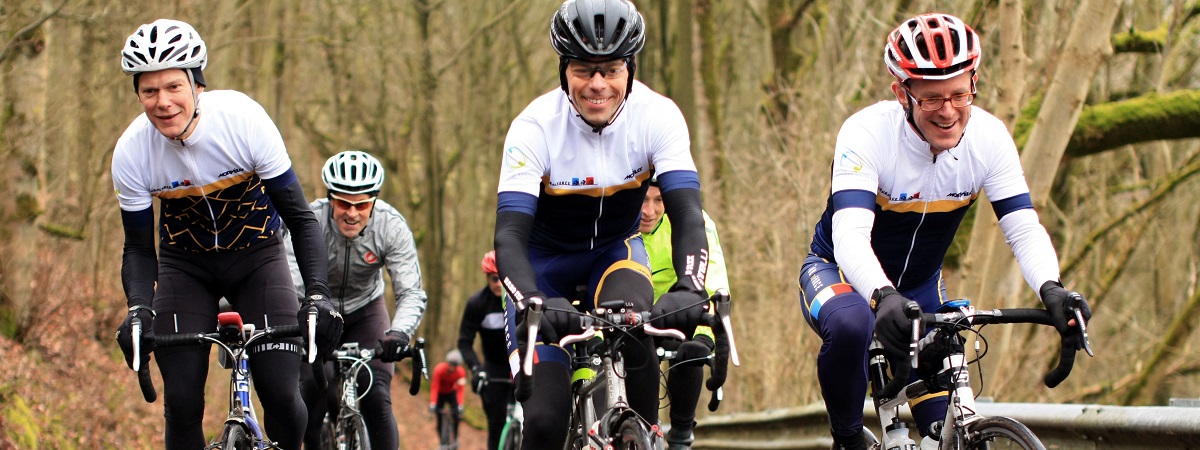Monthly motivation - December

At this stage of the year, you might be wondering where to start. You know you’re going to need to do a lot of cycling (something you love to do, right?) but it’s all a bit … well … daunting!
So how can you get your head into the right space for the challenge ahead? First up – we recommend reading some of the rider profiles on our ‘Is this for Me?’ page. Yes – we know you’ve already committed to Le Loop so that question has already been answered, but these are stories from riders who’ve ridden Le Loop from a full range of starting points: from virtual beginner, to highly experienced racer. You’re sure to find someone there who matches your profile (or near enough) and reading about their experience (and advice) will motivate you and perhaps help to reassure you that you CAN do this!
The rest of this monthly blog is all about planning …
Start Planning
Even if you don’t get out on your bike in earnest yet, now is the month to get your plans in place. Le Loop is a serious undertaking and more complicated that a 1 day sportive.
- Your training
- Your Team
- Your Kit
- Your work/life balance
Your Training
We’ve got some great training advice on our training pages in your Rider Account. Take a look. But let’s face it, there’s also a huge amount of information out there that you can tap into, from the gerzillions of videos on the GCN YouTube channel, to your own personal coach, not to mention club mates and Le Loop alumni.
Wherever you go for your training advice, at least start to get your head around what preparing for your Loop entails. Then make your plan, because just ‘winging it’ probably isn’t going to cut it!
If you’re going to use a turbo trainer or spin classes over the winter months, get that in place.
If you get any niggles now (hips, knees, bum) don’t ignore them – get them sorted straight away. Invest in massage or physio/medical advice. Don’t just hope they’ll go away – address any aches and pains before they become serious problems.
Now is a good time to mention a stretching regime and/or regular yoga. Find a class in real life, or on line (try Googling “15 minute post-bike ride yoga video” and try a few), or just a series of exercises that you stick to religiously. Buy a foam roller or a tennis ball and use them as massage aids to speed up recovery (don’t be put off by your first go – it gets less painful!). Start now and keep it going through the tour.
But the most important piece of advice? Be realistic. Don’t set yourself up with a regime you can never hope to stick to. And if you find you can do more than you thought? Great!
Your Team
Now’s the time to gather your team around you. This is the team you want to have on your side, rooting for you when the going gets tough.
Family & friends, kids, partner, parents or mates and even work colleagues can all be roped in to support you over the coming months.
They’re the ones who’ll encourage you to go for that ride even though the weather’s not great, or they’ll offer to look after the kids while you get a longer ride in. Perhaps they’ll be helping you to eat really well and for some of you, to abstain from alcohol for a while. Maybe they’ll be on training rides with you, making sure you push yourself from time to time, even on a filthy wet day (or slog it out for a long slow sunny one with plentiful café stops).
Ride buddies for most people are going to be crucial for motivation. Commit to a ride with someone and you’re less likely to duck out if the weather’s a bit iffy, or life feels too busy.
If you’re not a member of a cycling club, who do you know who can join you for at least some of your training rides? They don’t even have to commit to the same distances you’re riding – plan a local loop that you can repeat and they can join you for just 1 or 2 laps. Some riders are happy going solo, but if you’re not one of them, get your ride team in place.
Your Kit
If you’re in the Northern Hemisphere, you’re going to have to start getting the miles in well before the weather improves in the spring. Having the right kit is absolutely key to this but that doesn’t have to mean spending lots of money…
Make sure you’ve got the right clothing to stay as warm, dry and visible as possible. Gloves, neck warmers, knee and leg warmers can all be useful but a really good waterproof (jacket AND legs?) will make the most difference as well as a bit of reflective clothing for dark or grey days. And whilst a back pocket and other cycling-specific features are nice, it’s far more important that it’s comfortable and does the job so if you’re cycling in a thick, winter hiking jacket, that’s absolutely fine; the main goal is to stay warm and dry enough to enjoy the ride.
We’ll have Le Loop shorts, jerseys and caps for sale by January – which you don’t have to buy but they do get rave reviews for comfort, especially the shorts.
Now’s also the time to give some serious thought to your bike. When was the last time you gave your bike a full service (not the cheap one – the proper “full monty” one)? Do it now so that it will see you through the next few months … and book it in for another one just before you come on tour – it’ll need it after all the miles you’re going to be doing on it, and you want it in perfect condition on tour.
And to make the service (and the cost of it) last longer, don’t cut corners on the post-ride clean down, particularly over the mucky winter months. Look after your bike and it’ll look after you.
Your Work/Life Balance
Let’s be honest – whether you’re riding a couple of stages, or all 21, it’s likely that you’ll be riding your bike a lot more than usual. This takes some planning to fit it into what is probably an already very busy life.
Most typically it’s work and family that stop us training and sometimes there’s nothing you can do about that. If you need to organise your training around childcare or other family commitments, make sure that you commit equally to your non-cycling duties, so that when it’s your turn to head outdoors, you have the support and encouragement of those around you.
Work demands are tricky, but by explaining to colleagues why you need to make time, you may be surprised at how much support they offer.
However complex your work/life balance, anticipating and planning is going to make all the difference.
You’re probably going to have to be creative. For example, if you’re heading off somewhere with family for the weekend, maybe you start out on your bike early, and the family picks you up later en route.
Don’t underestimate the value of the commute – regular (shorter) riding most days goes further than you might think to helping base fitness. Can you take the ‘scenic’ route and leave a bit earlier in the morning/get home a bit later at night to get a few extra miles in? Where time is of the essence, is a stint on the turbo trainer or in a spinning class going to serve you just as well as 4 hours on the country lanes? Build it all into your training plan.
And don’t underestimate the recovery time you’ll need too. If you’re likely to get small children bouncing on top of you before you’ve even stripped off your lycra, then work out how to manage that if all you really feel capable of is lying on a sofa while consuming vast quantities of calories.
Equally, don’t underestimate the head space that the hours on the bike will give you, the improved fitness and energy. Riding your bike doesn’t need to challenge your work life balance – it should be a crucial component of it. Just get the balance right!
Vive Le Tour!


